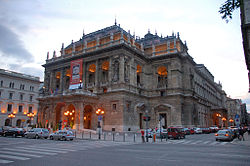Hungarian State Opera House


The building of the Hungarian State Opera House (Hungarian: Magyar Állami Operaház) is a splendid example of neorenaissaince architecture. It is located in central Pest, (a part of Budapest), in the 6th District (Terézváros) at Andrássy út 22.
Designed by Miklós Ybl, a major figure of 19th century Hungarian architecture, the construction lasted from 1875 to 1884 and was funded by the city of Budapest and by Emperor Franz Joseph of Austria-Hungary. The Hungarian Royal Opera House (as it was known then) opened to the public on the 27th of September 1884.
It is a richly-decorated building and is considered one of the architect's masterpieces. It was built in neorenaissaince style, with elements of baroque. Ornamentation includes paintings and sculptures by leading figures of Hungarian art of the time including Bertalan Székely, Mór Than and Károly Lotz. Although in size and capacity it is not among the greatest, in beauty and the quality of acoustics the Budapest Opera House is considered to be amongst the first few opera houses in the world.
The auditorium holds 1261 seats. It is horseshue shaped and - according to measurments done in the 1970's by a group of international engineers - has the 3rd best acoustics in Europe after the Scala in Milan and the Paris Opera House. Although many opera houses have been built since, the Budapest Opera House is still among the best in terms of the acoustics.
In front of the building are statues of Ferenc Erkel, composer of the Hungarian national anthem, and the first music director of the Opera House. He was also founder of the Budapest Philharmonic Orchestra. The other statue is of Franz Liszt, perhaps one of the best known Hungarian composers.
Each year the season lasts from September to the end of June and besides opera performances the Opera House is home to the Hungarian National Ballet.
Many important artist were guests here including Gustav Mahler the composer who was director in Budapest from 1887 to 1891 and Otto Klemperer who was music director for three years from 1947 to 1950.
In the 1970's the state of the building prompted the Hungarian State to order a major renovation which eventually began in 1980 and lasted till 1984. The reopening was held exactly 100 years after the original opening, on the 27th of September 1984.
The second house of the Hungarian State Opera is Erkel theatre. It is a much bigger building and it also hosts opera and ballet performances during the opera season.
There are guided tours in the building in six languages (English, German, Spanish, French, Italian and Hungarian) almost every day.
Notes
- Opera is also the name of the underground station located near the building.
- The building is located at 47°30′10″N 19°3′30″E / 47.50278°N 19.05833°E Coordinates: Extra unexpected parameters
External links
- Homepage (only in Hungarian; English version is under construction as of March 2, 2007)
- History of the Opera (in English)
- The interior of the Opera House
- Hungarian State Opera
- Photo of the details of the Opera House
- More information in English about the Budapest Opera
47°30′10″N 19°3′30″E / 47.50278°N 19.05833°E Coordinates: Extra unexpected parameters
